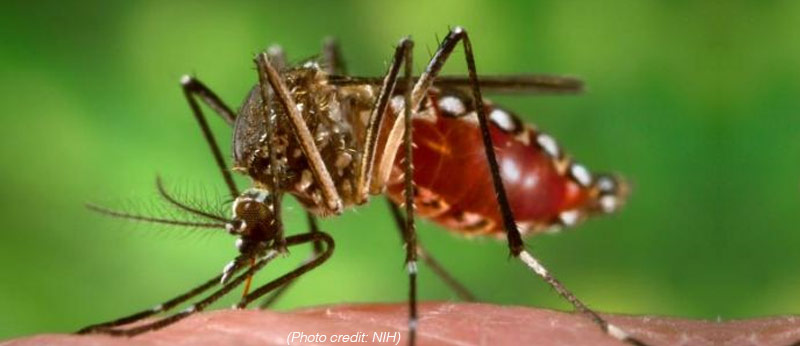The National Institutes of Health awarded Kacey Ernst more than $3 million in 2012 for research to prevent mosquito-borne infectious diseases that cause malaria and dengue.
 |
| The mosquito species Aedes aegypti is a dangerous carrier of the virus that causes dengue fever. (Photo Credit: NIH) |
Kacey Ernst, PhD, MPH, an assistant professor of epidemiology in the University of Arizona Mel and Enid Zuckerman College of Public Health, was awarded a $376,000 grant from the National Institutes of Health to develop community based solutions to improve malaria prevention and control efforts in Kenya. This is the third NIH grant – totaling more than $3 million – awarded to Ernst in 2012 for research related to the prevention of mosquito-borne diseases.
Ernst already is leading a UA team to track populations of the mosquito that carry the virus that causes dengue in Mexico and Southern Arizona. She also is principal investigator of a study collecting data on the mosquito in Key West, Fla., a hard-hit area. The data will be compared to data collected into Tucson.
 |
| Kacey Ernst, PhD, MPH |
Ernst has a personal connection to the cause of preventing malaria and dengue viruses due to her ties to Kenya, a place she has been traveling to for 15 years since completing her Master’s research in the country.
“I’ve always been interested in the links between environments and how humans can modify their environment to change their risk of disease,” said Ernst.
The focus of her research is the epidemiology of infectious diseases and the ties between environment and vector-borne diseases. Her doctoral dissertation research focused on malaria in the highlands of western Kenya, where she lived and worked for more than two years designing and administering a case-control study that examined environmental, behavioral, and socioeconomic determinants of malaria.
Malaria kills about 1 million people each year and is a leading cause of death in children under the age of five in Kenya. The use of bed nets treated with insecticide is one of the most common malaria prevention methods. Yet many people are still reluctant to use them.
The malaria prevention study will utilize focus groups and cross-sectional surveys to examine why or why not at-risk citizens are using bed nets. The goal of the study is to use existing knowledge from those who do use bed nets and spread this wisdom throughout Kenya.
The reasons why people are reluctant to use bed nets are varied, said Ernst. “Some people don’t like the feeling of being closed in, nets are difficult to hang, they may not have a standard bed, or they don’t have access to bed nets.”
Ernst said another contributing factor is that malaria has become so common in Kenya that people accept it as normal. “In a place where malaria is so rampant, people don’t fear the disease and see it as inevitable. So they don’t think it’s necessary to attempt to prevent it.”
The study will also consider the effectiveness of a program to distribute bed nets. In the past, there have been issues with the equitable distribution of free bed nets. One solution has been to require village elders to collect Kenyan I.D.’s from those acquiring bed nets and return the I.D. with a bed net, allowing for fairness and accountability from both the recipient and the village. The study will examine if this method was successful in advancing the amount of people utilizing bed nets and will determine which factors need to be improved.
Ernst will collaborate with researchers in Kenya to compare and contrast the use of bed nets in two different sites, with different transmission levels, to determine the best methods to put in place for malaria prevention.
At the same time, Ernst is working on two dengue prevention studies. She said the mosquito-borne dengue virus continues to be a risk in the southwest and on the rise in both intensity and geographic spread. “There are not as many vector control strategies in place in the U.S. for dengue virus as there is for malaria in Kenya,” said Ernst.
One of the studies involves tracking populations of the mosquito Aedes aegypti, a dangerous carrier of the virus that causes dengue, along a geographic line from Guaymas in southern Sonora, Mexico to Tucson with a $2.3 million grant from the NIH. The other involves collecting data on the mosquito that carries dengue in Key West, an area that has had an outbreak. Ernst will then compare it to Tucson, an area with the mosquito established but no recorded transmission. This study is funded by $400,000 NIH grant.
Said Ernst: “Disease transmission by mosquitoes is influenced by many factors, learning about how changes in climate and control implementation impact these diseases will allow us to prepare for and refine methods to reduce their impact on human health.”
The grant “Identifying community-based solutions that improve insecticide-treated net (ITN) use,” is supported by grant number 1R15AI100118-01 from the National Institutes of Health.








